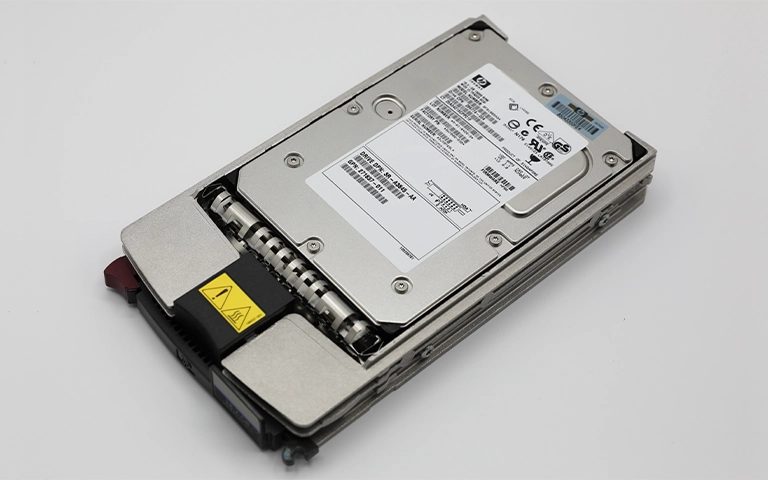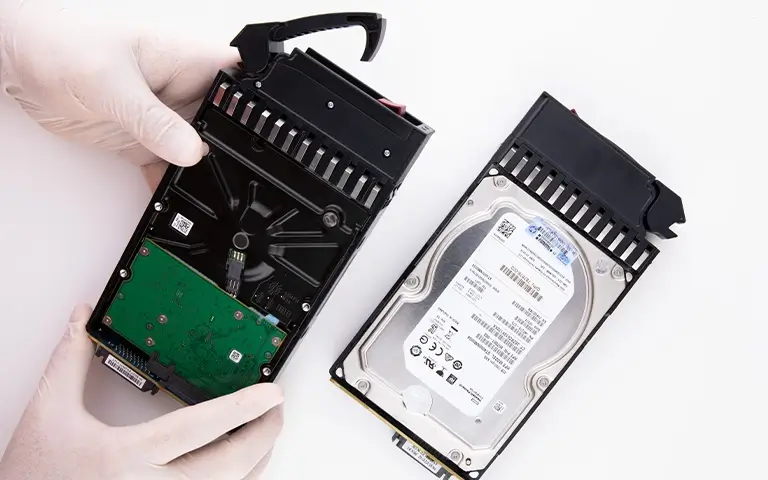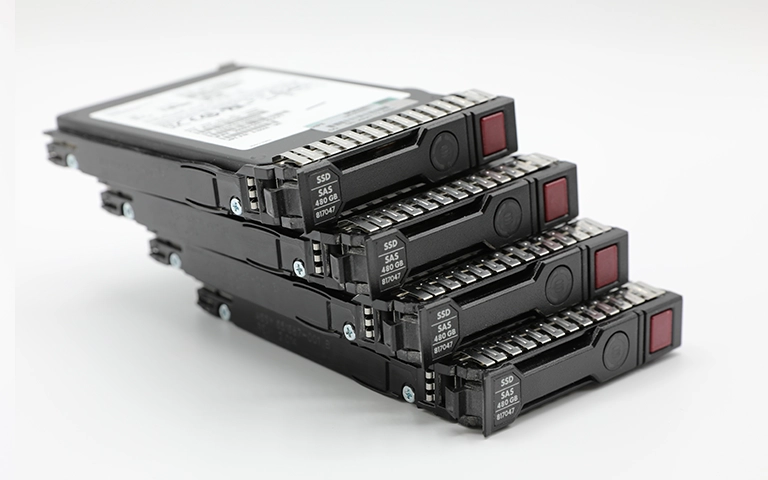When a RAID 0 volume fails, the impact is immediate and often severe. Unlike other RAID levels, RAID 0 offers no redundancy. Data is split evenly across multiple drives, meaning that if even one disk fails, the entire array becomes unreadable.
A “failed RAID volume detected” message typically signals corruption, disk failure, or controller malfunction.
At this point, accessing data without proper recovery can lead to permanent loss. Because RAID 0 depends on perfect synchronization between drives, even a small misstep in recovery can destroy the original structure of the array.
Understanding how RAID 0 operates and what causes its failure is the first step toward successful recovery.
This guide explains the main reasons for failure, the signs that indicate a problem, and how professionals safely recover volumes from RAID 0 without risking additional damage.

Understanding RAID 0 Configuration
RAID 0, also known as striping, combines two or more drives into one large volume to boost read and write speeds.
Instead of storing entire files on a single disk, the system splits data into blocks and distributes them evenly across all drives in the array. This design improves performance but completely sacrifices redundancy.
Because RAID 0 does not store parity or mirrored data, it cannot recover from a single disk failure. When one drive becomes unreadable, part of every file is lost, leaving the entire array inaccessible. This makes RAID 0 fast but extremely fragile when it comes to data protection.
RAID 0 is commonly used in gaming PCs, video editing workstations, or environments where speed is prioritized over fault tolerance.
However, users often underestimate how risky it is for storing critical files. To better understand how RAID levels differ in redundancy and performance, visit Types of RAID.
Common Causes of RAID 0 Volume Failure
RAID 0 systems are highly vulnerable to data loss since they lack redundancy. Even a single malfunction can make the entire array unreadable. Below are the most common reasons why a RAID 0 volume may fail:
Drive failure: If one disk in the array stops working, all stored data becomes incomplete and inaccessible.
Controller malfunction: A faulty or outdated RAID controller can disrupt the communication between drives, leading to corruption or volume loss. Learn more about these issues in RAID Controller Failure Recovery.
Power surges or outages: Sudden power interruptions can corrupt data structures and cause the array to fail during read or write operations.
Accidental reinitialization: Reinitializing or formatting the array without proper backup instantly erases the RAID configuration.
Software corruption: Faulty operating system updates or malware can damage partition tables and render volumes unmountable.
Physical damage: Heat, shock, or moisture can physically degrade drive components, resulting in total array failure.
Any of these issues can trigger the “failed RAID volume detected” message, signaling that the array can no longer function properly. Quick and professional response is essential to prevent irreversible data loss.

Signs of a Failed RAID 0 Volume
Recognizing the early signs of RAID 0 failure can help you act before data becomes permanently inaccessible. Common warning indicators include:
Error messages during startup: The system may show alerts such as “RAID volume failed” or “array degraded.”
Missing or unrecognized partitions: Drives may disappear from File Explorer or Disk Management.
Unusual noises from drives: Clicking, grinding, or spinning irregularities often point to mechanical failure.
Slow system performance: Longer loading times or data transfer delays suggest the array is struggling to read striped data.
Inaccessible files or corrupted folders: Files may open partially, fail to load, or appear with errors.
System freezes or crashes: Frequent freezes when accessing large files can indicate a failing drive within the array.
If your system shows any of these symptoms, stop using the array immediately. Continued operation may overwrite the striped data and make recovery impossible.
Why DIY Recovery Can Be Risky
Attempting to recover a failed RAID 0 volume on your own can make the situation much worse. RAID 0 arrays rely on precise data striping patterns, and even small errors in drive order or stripe size can destroy the structure permanently.
Many users try using recovery software or reinitializing the array, thinking it will restore access. In reality, these actions often overwrite the original data or corrupt parity alignment, making professional recovery much harder. Powering the system repeatedly or swapping drives can also cause additional hardware stress or logical inconsistencies.
If a RAID 0 array fails, the safest approach is to stop all activity and disconnect the drives. At this stage, only professional recovery can ensure that data is extracted safely without modifying the original structure. For initial troubleshooting guidance before recovery begins, visit Troubleshoot RAID Failure.

Fast turnaround times for business-critical data
Professional Recovery Process for RAID 0
Recovering data from a failed RAID 0 volume requires specialized tools, controlled environments, and a deep understanding of how striped data is stored. At RAID Recovery Services, our engineers follow a systematic approach to maximize recovery success while protecting the integrity of every drive.
Each drive in the array is tested to identify mechanical, electronic, or logical issues. This helps determine whether physical repair or firmware work is needed before imaging begins.
Instead of working directly on the damaged disks, engineers create sector-by-sector images of all drives. This prevents further degradation and ensures a safe copy for reconstruction.
Using specialized tools, the team analyzes stripe size, block order, and offsets to rebuild the array virtually. This step restores the original structure without using the damaged hardware.
Once the array is reconstructed, corrupted file systems are repaired, and recoverable data is extracted to secure storage for verification.
Because RAID 0 recovery involves no redundancy, accuracy and precision are critical. Professional recovery ensures that data is handled safely and efficiently, even when multiple drives are affected.

Conclusion and Expert Support
RAID 0 offers impressive speed, but its lack of redundancy makes it one of the most fragile storage configurations. When a single drive fails, the entire array becomes unreadable, putting all stored data at risk.
Recognizing failure signs early and avoiding quick DIY fixes can make the difference between successful recovery and permanent loss.
If your system displays a “failed RAID volume detected” message or files suddenly disappear, disconnect the drives immediately and seek professional help.
At RAID Recovery Services, our engineers specialize in recovering RAID 0 arrays that have suffered drive failures, controller damage, or accidental reinitialization.
We use advanced imaging and reconstruction techniques to restore data safely and reliably. To understand how often RAID arrays experience failure and how to prevent it, review RAID Failure Rate. Acting quickly and relying on professionals gives your data the best chance of full recovery.
Trust the experts with proven results
Frequently Asked Questions
What happens when a RAID 0 volume fails?
In a RAID 0 setup, data is divided into blocks and stored across multiple drives. If one drive fails, all files become inaccessible because parts of every file are missing. The array cannot rebuild itself due to the lack of redundancy.
Can data be recovered from a failed RAID 0 volume?
Yes. Even though RAID 0 has no fault tolerance, professional recovery engineers can often rebuild the array virtually by analyzing each drive’s structure, stripe size, and order to extract data safely.
Why should I avoid using software recovery tools on RAID 0?
Software tools may write to the drives or use incorrect stripe parameters, permanently damaging the array. Professional recovery prevents this by working from secure drive images rather than the original disks.
What are the most common reasons for RAID 0 failure?
Typical causes include drive failure, controller malfunction, accidental reinitialization, power surges, or corrupted file systems. Physical damage to any drive will also make the array unusable.
How can I protect my RAID 0 data in the future?
Regularly back up your files to external or cloud storage and monitor drive health closely. RAID 0 should only be used for temporary or non-critical data where performance is more important than redundancy.